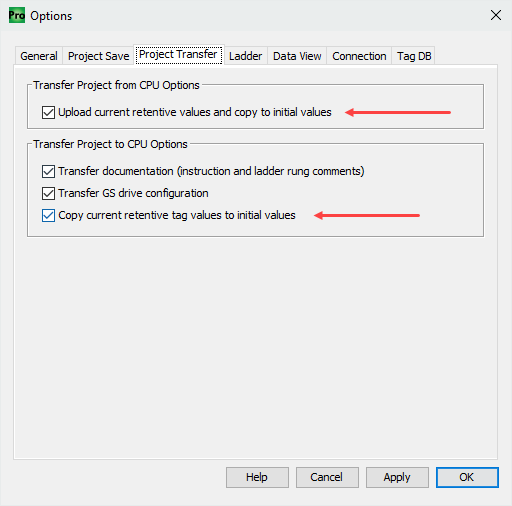|
|
Topic: P030 |
Run Time vs. Stop Mode Transfer |
|
|
|
Topic: P030 |
Run Time vs. Stop Mode Transfer |
|
In this Topic we describe the actions and differences between Run Time and Stop Mode Transfers.
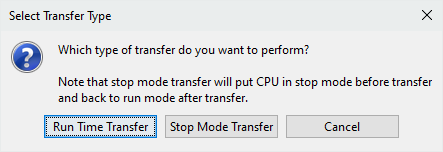
The above dialog is accessed two ways:
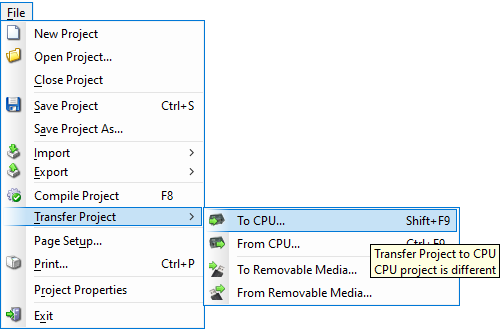
Run Time Transfers allow the user to transfer project edits into the CPU without stopping the CPU scan, therefore not stopping the process. Be aware that a Run Time Transfer will affect the length of your scan time, which should be considered if your process is susceptible to varying or lengthy scan times. The download time is longer compared to a Stop Mode Transfer.
During a Run Time Transfer, the current project file continues running until the entire project file is Transferred to the CPU. Once downloaded, the ladder logic files swap and begin executing the new file. The Tag Database is shared between the two project files during a Run Time Transfer, therefore current operating values will not be effected.
Stop Mode Transfers are faster than Run Time Transfers because execution of the project is halted during the transfer. Some changes to a project cannot be handled by a Run Time Transfer, so must be downloaded using Stop Mode Transfer.
Here are some changes that will force the user to perform a Stop Mode Transfer:
- Any changes to the Hardware Configuration (Adding, removing, or modification) will require a Stop Mode Transfer.
a. Adding or removing hardware.
b. Changing the configuration of a piece of hardware.
Ethernet or serial port configuration.
Hot swap enable or disable on any module of base.
c. Adding or removing and any configuration changes to any of the following:
GS Drives
ProtosX modules
EtherNet/IP devices
MQTT clients
CPoE devices
ProNet devices
PS-AMC devices
Mail Accounts
- Adding > 5000 tags of any data type . (Excluding Strings and Structures)
Note:This limit is accumulated between each stop mode transfer.
- Adding > 50,000 characters or changing the length of a String data type Tags.
Note:This limit is accumulated between each stop mode transfer.
- Deleting or changing the size of array tags or string tags.
- Changes to Modbus Server settings under Project Properties.
- Changes to the buffer size for a FILI instruction.
- Adding tags that are structure data types where total number of elements is > 5,000 or total character count is > 50,000. For example, creating a 1D array tag ‘array’ with 501 elements of a structure data type that has 10 elements in the structure will exceed the 5000 elements.
Note:This limit is accumulated between each stop mode transfer.
- Enabling Bit of Word under Project Properties.
- Enabling Structures in under Project Properties.
- Enable and Disable of EtherNet/IP Adapter.
At any time, the availability of Run Time Transfer can be verified on the status bar at the bottom of the Productivity Suite window.
A CPU Project Status of ‘Out of Date’ in the status bar indicates if a change has been made to the program in Productivity Suite that makes it not equal with the program running in the CPU (a status of ‘Up to Date’ means there is no difference between the Productivity Suite program and the program running on the CPU).
Note: Changes to DataView, Bit or Word Histograms, PID Tuning, and Set CPU Time/Date do not affect the CPU Project Status.
Note: Tag Database changes that require a Stop Mode transfer may not change the ‘Run Time Transfer’ status in the status bar, but attempting to do a Run Time Transfer will result in an error message indicating why a Stop Mode Transfer is required
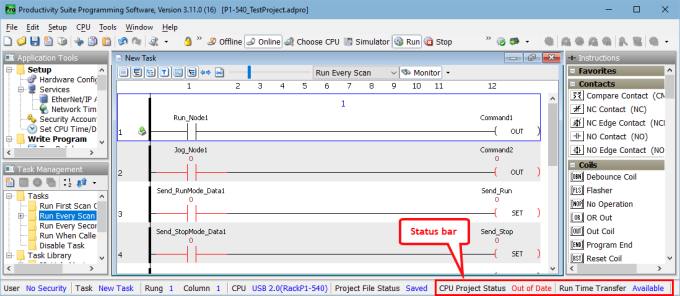
If Run Time Transfer is not available when Transfer Project to CPU is selected, the following dialog will appear.
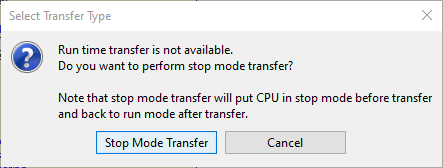
As the CPU goes from stop to run after a Stop Mode Transfer, tags are initialized as if the project is being executed for the first time. This includes Retentive Tags. For more information see the Tag Initialization topic.
If it's desirable that the values of Retentive Tags be retained through a Stop Mode Transfer, there are two methods available. Both options may be enabled. They can be found under Tools > Options > Project Transfer:
